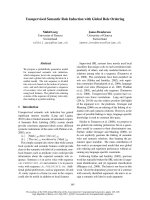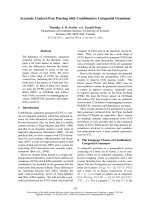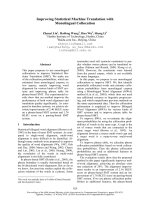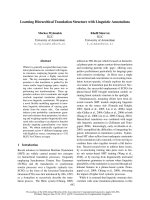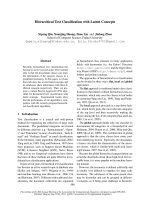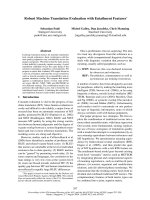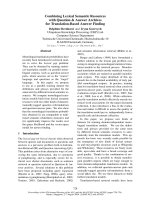Báo cáo khoa học: "Reducing SMT Rule Table with Monolingual Key Phrase" potx
Bạn đang xem bản rút gọn của tài liệu. Xem và tải ngay bản đầy đủ của tài liệu tại đây (134.17 KB, 4 trang )
Proceedings of the ACL-IJCNLP 2009 Conference Short Papers, pages 121–124,
Suntec, Singapore, 4 August 2009.
c
2009 ACL and AFNLP
Reducing SMT Rule Table with Monolingual Key Phrase
Zhongjun He
†
Yao Meng
†
Yajuan L
‡
Hao Yu
†
Qun Liu
‡
†
Fujitsu R&D Center CO., LTD, Beijing, China
{hezhongjun, mengyao, yu}@cn.fujitsu.com
‡
Key Laboratory of Intelligent Information Processing
Institute of Computing Technology, Chinese Academy of Sciences, Beijing, China
{lvyajuan, liuqun}@ict.ac.cn
Abstract
This paper presents an effective approach
to discard most entries of the rule table for
statistical machine translation. The rule ta-
ble is filtered by monolingual key phrases,
which are extracted from source text us-
ing a technique based on term extraction.
Experiments show that 78% of the rule ta-
ble is reduced without worsening trans-
lation performance. In most cases, our
approach results in measurable improve-
ments in BLEU score.
1 Introduction
In statistical machine translation (SMT) commu-
nity, the state-of-the-art method is to use rules that
contain hierarchical structures to model transla-
tion, such as the hierarchical phrase-based model
(Chiang, 2005). Rules are more powerful than
conventional phrase pairs because they contain
structural information for capturing long distance
reorderings. However, hierarchical translation
systems often suffer from a large rule table (the
collection of rules), which makes decoding slow
and memory-consuming.
In the training procedure of SMT systems, nu-
merous rules are extracted from the bilingual cor-
pus. During decoding, however, many of them are
rarely used. One of the reasons is that these rules
have low quality. The rule quality are usually eval-
uated by the conditional translation probabilities,
which focus on the correspondence between the
source and target phrases, while ignore the quality
of phrases in a monolingual corpus.
In this paper, we address the problem of reduc-
ing the rule table with the information of mono-
lingual corpus. We use C-value, a measurement
of automatic term recognition, to score source
phrases. A source phrase is regarded as a key
phrase if its score greater than a threshold. Note
that a source phrase is either a flat phrase consists
of words, or a hierarchical phrase consists of both
words and variables. For rule table reduction, the
rule whose source-side is not key phrase is dis-
carded.
Our approach is different from the previous re-
search. Johnson et al. (2007) reduced the phrase
table based on the significance testing of phrase
pair co-occurrence in bilingual corpus. The ba-
sic difference is that they used statistical infor-
mation of bilingual corpus while we use that of
monolingual corpus. Shen et al. (2008) pro-
posed a string-to-dependency model, which re-
stricted the target-side of a rule by dependency
structures. Their approach greatly reduced the rule
table, however, caused a slight decrease of trans-
lation quality. They obtained improvements by
incorporating an additional dependency language
model. Different from their research, we restrict
rules on the source-side. Furthermore, the system
complexity is not increased because no additional
model is introduced.
The hierarchical phrase-based model (Chiang,
2005) is used to build a translation system. Exper-
iments show that our approach discards 78% of the
rule table without worsening the translation qual-
ity.
2 Monolingual Phrase Scoring
2.1 Frequency
The basic metrics for phrase scoring is the fre-
quency that a phrase appears in a monolingual cor-
pus. The more frequent a source phrase appears in
a corpus, the greater possibility the rule that con-
tains the source phrase may be used.
However, one limitation of this metrics is that if
we filter the rule table by the source phrase with
lower frequency, most long phrase pairs will be
discarded. Because the longer the phrase is, the
less possibility it appears. However, long phrases
121
are very helpful for reducing ambiguity since they
contains more information than short phrases.
Another limitation is that the frequency metrics
focuses on a phrase appearing by itself while ig-
nores it appears as a substring of longer phrases.
It is therefore inadequate for hierarchical phrases.
We use an example for illustration. Considering
the following three rules (the subscripts indicate
word alignments):
R
1
:
1 2 3 4 5
accept
1
President
3
Bush
2
’s
4
invitation
5
R
2
:
1 2
X
3 4 5
accept
1
X
3
Bush
2
’s
4
invitation
5
R
3
:
1
X
2 3 4
accept
1
X
2
’s
3
invitation
4
We use f
1
, f
2
and f
3
to represent their source-
sides, respectively. The hierarchical phrases f
2
and f
3
are sub-strings of f
1
. However, R
3
is sug-
gested to be more useful than R
2
. The reason is
that f
3
may appears in various phrases, such as
“
, accept France ’s invitation”.
While f
2
almost always appears in f
1
, indicating
that the variable X may not be replaced with other
words expect “President”. It indicates that R
2
is
not likely to be useful, although f
2
may appears
frequently in a corpus.
2.2 C-value
C-value, a measurement of automatic term recog-
nition, is proposed by Frantzi and Ananiadou
(1996) to extract nested collocations, collocations
that substrings of other longer ones.
We use C-value for two reasons: on one hand,
it uses rich factors besides phrase frequency, e.g.
the phrase length, the frequency that a sub-phrase
appears in longer phrases. Thus it is appropriate
for extracting hierarchical phrases. On the other
hand, the computation of C-value is efficient.
Analogous to (Frantzi and Ananiadou, 1996),
we use 4 factors (L, F, S, N) to determine if a
phrase p is a key phrase:
1. L(p), the length of p;
2. F (p), the frequency that p appears in a cor-
pus;
Algorithm 1 Key Phrase Extraction
Input: Monolingual Text
Output: Key Phrase Table KP
1: Extract candidate phrases
2: for all phrases p in length descending order
do
3: if N (p) = 0 then
4: C-value = (L(p) − 1) × F (p)
5: else
6: C-value = (L(p) − 1) × (F (p) −
S(p)
N(p)
)
7: end if
8: if C-value ≥ ε then
9: add p to KP
10: end if
11: for all sub-strings q of p do
12: S(q) = S(q) + F (p) − S(p)
13: N(q) = N(q) + 1
14: end for
15: end for
3. S(p), the frequency that p appears as a sub-
string in other longer phrases;
4. N(p), the number of phrases that contain p as
a substring.
Given a monolingual corpus, key phrases can be
extracted efficiently according to Algorithm 1.
Firstly (line 1), all possible phrases are ex-
tracted as candidates of key phrases. This step
is analogous to the rule extraction as described in
(Chiang, 2005). The basic difference is that there
are no word alignment constraints for monolingual
phrase extraction, which therefore results in a sub-
stantial number of candidate phrases. We use the
following restrictions to limit the phrase number:
1. The length of a candidate phrase is limited to
pl;
2. The length of the initial phrase used to create
hierarchical phrases is limited to ipl;
3. The number of variables in hierarchical
phrases is limited to nv, and there should be
at least 1 word between variables;
4. The frequency of a candidate phrase appears
in a corpus should be greater than freq.
In our experiments, we set pl = 5, ipl = 10, nv =
2, freq = 3. Note that the first 3 settings are used
in (Chiang, 2005) for rule extraction.
122
Secondly (line 3 to 7), for each candidate
phrase, C-value is computed according to the
phrase appears by itself (line 4) or as a substring
of other long phrases (line 6). The C-value is in
direct proportion to the phrase length (L) and oc-
currences (F, S), while in inverse proportion to the
number of phrases that contain the phrase as a sub-
string (N ). This overcomes the limitations of fre-
quency measurement. A phrase is regarded as a
key phrase if its C-value is greater than a thresh-
old ε.
Finally (line 11 to 14), S(q) and N (q) are up-
dated for each substring q.
We use the example in Section 2.1 for illustra-
tion. The quadruple for f
1
is (5, 2, 0, 0), indicating
that the phrase length is 5 and appears 2 times by
itself in the corpus. Therefore C-value(f
1
) = 8.
The quadruple for f
2
is (4, 2, 2, 1), indicating that
the phrase length is 4 and appears 2 times in the
corpus. However, the occurrences are as a sub-
string of the phrase f
1
. Therefore, C-value(f
2
) =
0. While the quadruple for f
3
is (3, 11, 11, 9),
which indicates that the phrase length is 3 and ap-
pears 11 times as a substring in 9 phrases, thus
C-value(f
3
) = 19.6. Given the threshold ε = 5,
f
1
and f
3
are viewed as key phrases. Thus R
2
will
be discarded because its source-side is not a key
phrase.
3 Experiments
Our experiments were carried out on two language
pairs:
• Chinese-English: For this task, the corpora
are from the NIST evaluation. The parallel
corpus
1
consists of 1M sentence pairs . We
trained two trigram language models: one on
the Xinhua portion of the Gigaword corpus,
and the other on the target-side of the paral-
lel corpus. The test sets were NIST MT06
GALE set (06G) and NIST set (06N) and
NIST MT08 test set.
• German-English: For this task, the corpora
are from the WMT
2
evaluation. The paral-
lel corpus contains 1.3M sentence pairs. The
target-side was used to train a trigram lan-
guage model. The test sets were WMT06 and
WMT07.
1
LDC2002E18 (4,000 sentences), LDC2002T01,
LDC2003E07, LDC2003E14, LDC2004T07, LDC2005T10,
LDC2004T08
HK Hansards (500,000 sentences)
2
/>For both the tasks, the word alignment were
trained by GIZA++ in two translation directions
and refined by “grow-diag-final” method (Koehn
et al., 2003). The source-side of the parallel cor-
pus is used to extract key phrases.
3.1 Results
We reimplemented the state-of-the-art hierarchical
MT system, Hiero (Chiang, 2005), as the baseline
system. The results of the experiments are shown
in Table 1 and Table 2.
Table 1 shows the C-value threshold effect
on the size of the rule table, as well as the
BLEU scores. Originally, 103M and 195M rules
are respectively extracted for Chinese-English and
German-English. For both the two tasks, about
78% reduction of the rule table (for Chinese-
English ε = 200 and for German-English ε =
100) does not worsen translation performance. We
achieved improvements in BLEU on most of the
test corpora, except a slight decrease (0.06 point)
on WMT07.
We also compared the effects of frequency and
C-value metrics for the rule table reduction on
Chinese-English test sets. The rule table is re-
duced to the same size (22% of original table)
using the two metrics, separately. However, as
shown in Table 2, the frequency method decreases
the BLEU scores, while the C-value achieves im-
provements. It indicates that C-value is more ap-
propriate than frequency to evaluate the impor-
tance of phrases, because it considers more fac-
tors.
With the rule table filtered by key phrases on
the source side, the number of source phrases re-
duces. Therefore during decoding, a source sen-
tence is suggested to be decomposed into a num-
ber of “key phrases”, which are more reliable than
the discarded phrases. Thus the translation quality
does not become worse.
3.2 Adding C-value as a Feature
Conventional phrase-based approaches performed
phrase segmentation for a source sentence with a
uniform distribution. However, they do not con-
sider the weights of source phrases. Although any
strings can be phrases, it is believed that some
strings are more likely phrases than others. We
use C-value to describe the weight of a phrase in
a monolingual corpus and add it as a feature to the
translation model:
123
C-value Chinese-English Germany-English
Threshold ε Rule Table (%) 06G 06N 08 Rule Table (%) 06 07
0 100% 12.43 28.58 21.57 100% 27.30 27.95
5 61% 12.22 28.40 21.33 54% 27.39 28.05
20 44% 12.24 28.29 21.21 37% 27.47 27.94
100 28% 12.36 28.56 21.67 22% 27.54 27.89
200 22% 12.66 28.69 22.12 17% 27.26 27.80
300 20% 12.41 27.76 21.52 15% 27.41 27.69
400 18% 11.88 26.98 20.70 13% 27.36 27.76
500 16% 11.65 26.40 20.32 12% 27.25 27.76
Table 1: C-value threshold effect on the rule table size and BLEU scores.
System Rule Table (%) 06G 06N 08
Baseline 100% 12.43 28.58 21.57
Frequency 22% 12.24 27.77 21.20
C-value 22% 12.66 28.69 22.12
∗
+CV-Feature 22% 12.89
∗
29.22
∗+
22.56
∗+
Table 2: BLEU scores on the test sets of the Chinese-English task.
∗
means significantly better than
baseline at p < 0.01.
+
means significantly better than C-value at p < 0.05.
h(F
J
1
) =
K
k=1
log(C-value(
f
k
)) (1)
where,
f
k
is the source-side of a rule.
The results are shown in the row +CV-Feature
in Table 2. Measurable improvements are ob-
tained on all test corpora of the Chinese-English
task by adding the C-value feature. The improve-
ments over the baseline are statistically significant
at p < 0.01 by using the significant test method
described in (Koehn, 2004).
4 Conclusion
In this paper, we successfully discarded most
entries of the rule table with monolingual key
phrases. Experiments show that about 78% of the
rule table is reduced and the translation quality
does not become worse. We achieve measurable
improvements by incorporating C-value into the
translation model.
The use of key phrases is one of the simplest
method for the rule table reduction. In the future,
we will use sophisticated metrics to score phrases
and reduce the rule table size with the information
of both the source and target sides.
References
David Chiang. 2005. A hierarchical phrase-based
model for statistical machine translation. In Pro-
ceedings of the 43rd Annual Meeting of the Associa-
tion for Computational Linguistics, pages 263–270.
Katerina T. Frantzi and Sophia Ananiadou. 1996.
Extracting nested collocations. In COLING1996,
pages 41–46.
Howard Johnson, Joel Martin, George Foster, and
Roland Kuhn. 2007. Improving translation qual-
ity by discarding most of the phrasetable. In Pro-
ceedings of the 2007 Joint Conference on Empirical
Methods in Natural Language Processing and Com-
putational Natural Language Learning (EMNLP-
CoNLL), pages 967–975, Prague, Czech Republic,
June.
Philipp Koehn, Franz J. Och, and Daniel Marcu. 2003.
Statistical phrase-based translation. In Proceedings
of HLT-NAACL 2003, pages 127–133.
Philipp Koehn. 2004. Statistical significance tests for
machine translation evaluation. In Proceedings of
the 2004 Conference on Empirical Methods in Natu-
ral Language Processing (EMNLP), pages 388–395.
Libin Shen, Jinxi Xu, and Ralph Weischedel. 2008.
A new string-to-dependency machine translation al-
gorithm with a target dependency language model.
In Proceedings of ACL-08: HLT, pages 577–585,
Columbus, Ohio, June.
124

